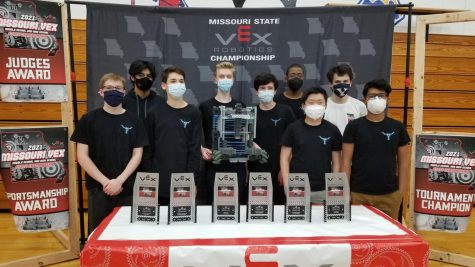“We had made it our goal to win this award two years ago. I was actually assuming that they were going to say [the name of another] team that had won last year,” senior Ankita Gupta recalled.
Gupta and her robotics team, 5430V, had committed to winning the Design Award at a robotics competition since their team’s formation. The competitions usually consist of a unique challenge set by VEX Robotics, requiring either driver-controlled or autonomous, manually-coded bots. The robot’s performance and the engineering notebook, which details the design and building process, largely determine the sole winner of the award. After many failed attempts, the V-team reorganized their engineering notebook, which finally landed them their long-desired goal.
“All three of us, we just kind of looked at each other. We were like, ‘are we sure they said our name?’ We slowly started getting up, walking down the bleachers,” Gupta said. “We all had masks on, but I think you could tell by our eyes that we were really smiling a lot. It was a feeling of accomplishment and happiness.”
Additionally, all four teams are ranked in the state’s top 15 for their skills, the 5430C team ranking first in the state and 30th in the country. They qualified for and won multiple awards at this weekend’s State Championship and one team is advancing to the World Championship. The four teams have collectively won the Excellence Award, the Robot Skills Champion Award, the Tournament Finalist Award, the Design Award, the Amaze Award and the Think Award for their performance at competitions.
“Each team keeps a log of what we’ve done that has progress, daily logs, the design process, drawings of the bot, problems we’ve encountered,” junior Lilly Blanton, a member of the V team, said. “The Design Award takes that notebook, the bot’s overall design and the judges’ interview, and the team that did a good job overall wins that. We took eighth place and made it to the quarterfinals.”
Aside from competitions, the robotics teams also recently contributed to making and distributing personal protective equipment such as face shields to medical and service workers on the front line.
“[Students with] 3D printers printed face shield cradles and tension release bands and then distributed them to people in need. The school also got a couple of new 3D printers to help with the effort,” Blanton said.
Blanton, who has been in robotics since freshman year, says that the unconventional school year has caused problems with scheduling meetings and learning to work together as a team. Whereas all four teams would usually be collaborating and sharing ideas and code, each team has to meet separately at a team member’s house for now. 5430V typically meets only once a week for six hours.
“My team formed last year as an all-girls team. We’ve just been working hard to try and figure out a way to work together. We try to collaborate [with other teams when] we can, but this year we’re functioning as different teams,” Blanton said.
Although there are still several teams during a normal school year, Blanton says that the shared feeling of community is currently lacking. The teams have become more independent this year and haven’t been able to celebrate their achievements together.
“[The team was] really happy when the A-team won State [last school year] and got invited to [the VEX World Championships]. We all work individually, build our own bot, code our own stuff, but we’re still really happy when someone else wins,” Blanton said. “It’s like in sports. When one person gets a goal, it’s a goal for the entire team.”
The robotics program is also very similar to a job according to Blanton. Every team member has different roles and responsibilities which affect the success of the overall team. Blanton is her team’s Systems Integration Officer, and she prepares for competitions by going over inventory, coding the driver-controlled, testing and programming the autonomous and making sure the teams have everything they need. Although they are occupied with their respective jobs, the team members are always there to help if a mistake occurs.
“We were supposed to have a competition [on] Saturday, and our [autonomous] wasn’t working,” Blanton said. “Then on Wednesday night, I accidentally deleted all of the code. We had to rebuild it, and I had to spend four hours recoding everything. [I felt] guilt because it was my code that kept breaking.”
Aside from other team members, robotics students also receive support from robotics sponsors Chris Donaldson and Joe Milliano. Blanton believes that the teams wouldn’t be as successful without Milliano and Donaldson’s dedication and the experiences of older robotics members.
“We have good coaches who work a lot to try to help us with any problems and keep us running smoothly. They put a lot of money into gaining the parts we need,” Blanton said. “We also have a good track record, so we know how to solve various problems by looking back at previous years. It’s always easier to continue something than it is to get it off the ground and start it.”
Along with great coaches and team members, the robotics program has greater diversity compared to the industry statistics. The school’s teams have more women, ethnicities and people of color. Junior Trisha Manna appreciates this aspect of the team and hopes that female participation in STEM continues to grow.
“We need representation from more minority groups. It’s probably not enough that we have one girl group. I think there could still be more people of different backgrounds represented. It’s good to be supporting people who aren’t always represented in STEM,” Manna said. “I wish more people knew that they could just join [robotics]. It’s a good environment. You don’t have to be an expert to join the robotics team and be a contributing member. If more people joined the team, I think they could find a passion for these things.”

(Chris Donaldson)
Gupta, the robotics team’s vice president, took initiative last year and created the 5430V girls team, hoping to give more students the opportunity to be involved in the engineering and design process. Gupta says many other schools in the area have larger teams, and not all team members are incorporated in the building process.
“Some of the guys on the team wouldn’t listen to our ideas or think of us as an equal part of the team. Since West has the financial capabilities to [host] more than two teams, I was able to branch off and start a new team in which more people could be heard and involved,” Gupta said. “[West] having four different teams allows the groups to be smaller and everyone on that team to be more involved in the whole process.”
Despite the great opportunities that robotics offers, there are only between 50 and 100 middle and high school teams in Missouri. The program, therefore, provides a unique opportunity for West students to pursue their engineering and coding passions in a process-based way. This makes it accessible for students with disabilities to participate and be successful in robotics. Blanton, who is deaf, says that her disability does not hinder her robotics achievements.
“[My disability] has made it more difficult for me to understand what people are saying in competitions. I’ll stick to one or two members of my team and not really wander off. The people on my team are good about making sure I can hear them,” Blanton said. “It’s helped me become more persevering. I’m more willing to step outside of my comfort zone. Having to be on a team where I’m constantly contacting officers, other teams or Mr. Donaldson or Mr. Milliano has helped me with social anxiety.”
Manna is the only virtual student on the team. Although she has not been able to attend meetings in-person, she has contributed to the team by working on the competition notebook and participating in a virtual competition, in which she made a video about diversity in STEM.
“I haven’t been able to contribute as much as I would like to. I haven’t been an integral part of the building process,” Manna said. “Before I started working on the notebook, I felt like I wasn’t really a part of the team. I’ve learned how [I] can contribute when it feels like [I’m] limited in what [I’m] able to do.”
For Gupta, the robotics program has provided her with opportunities to explore and develop her passions. Whereas she didn’t even know how to code in freshman year, she has now made the decision to pursue higher education in engineering.
“I haven’t loved the high school experience. Robotics is something that makes me wish I had another year that didn’t go away in COVID[-19]. It’s not something that’s only for people who want to pursue engineering,” Gupta said. “[During] freshman year, I had no clue what I wanted to do. I got opportunities with engineering through robotics, to learn about aerospace engineering. Now, that’s what I will be majoring in. It helped me realize what I want to do with my life.”


![Sitting behind the A-team’s robot, junior and robotics team president Rick Biswas converses about the bot with Donaldson, who is behind the camera. Since joining the robotics team, Biswas decided to pursue a related career such as mechanical engineering or computer science. “. After I joined [the robotics team at West], I knew for sure that this was what I wanted to do,” Biswas said. “In general, everyone’s really supportive, especially Mr. Donaldson and the teams. Before I joined the robotics team, I was new here and I didn’t talk to many people. At robotics, I met new people, made new friends. They supported me to be [who] I am right now. ”](https://pwestpathfinder.com/wp-content/uploads/2021/03/5430A_Closeup-4-900x675.jpg)
![Gazing up from the stage, junior Joseph McCurdy who played Peter Pan in the school play, Lost Girl, sits next to senior Juliana Rogers, who plays Wendy Darling, during a theater rehearsal. McCurdy’s passion for theater began when he observed a West High production in middle school. “I've been in the high school theater program since I was a freshman. I've always loved theater, but [what prompted me to join] was [when] I went to see [a performance here] when I was in middle school, and it was super cool,” McCurdy said.](https://pwestpathfinder.com/wp-content/uploads/2025/11/IMG_6535-1200x798.jpeg)

![Standing tall, stacked in a precise formation, the cheer team strikes a signature pose during halftime on Sept. 12 at the varsity football game. Nearly a month after this performance, the cheer team performed at the Missouri Cheerleading Coaches Association (MCCA) regional competition on Oct. 4, 2025. “We've all come [to] work together a lot more,” sophomore Elyssa Philippi said. “We're a lot closer than we were [earlier in the season] and going to state has made us closer [in] trying to work with each other, learn [new] skills and make our team better.”](https://pwestpathfinder.com/wp-content/uploads/2025/11/DSC5139-1.jpg)
![Handing out candy to excited trunk-or-treaters, President of the United Nations Children’s Fund club and junior Sara Ashok represents that group. Ashok was eager to participate in this event for multiple reasons. “I really wanted to be a part of the event because I get to help create memories for kids and spend time with my friends, spreading the things [I'm passionate about],” Ashok said.](https://pwestpathfinder.com/wp-content/uploads/2025/11/DSC_8648-1-1200x800.jpg)

![Smiling in a sea of Longhorns, Fox 2 reporter Ty Hawkins joins junior Darren Young during the morning Oct. 3 pep rally. The last time West was featured in this segment was 2011. “[I hope people see this and think] if you come to [Parkway] West, you will have the time of your life because there are so many fun activities to do that make it feel like you belong here. I was surprised so many people attended, but it was a lot of fun,” Young said.](https://pwestpathfinder.com/wp-content/uploads/2025/10/Edited2-1200x798.jpg)
![West High seniors and families listen as a representative of The Scholarship Foundation of St. Louis, Teresa Steinkamp, leads a Free Application for Federal Student Aid (FAFSA) workshop. This session, held in the library, provided guidance on financial aid, scholarships and student loan options. “This event is very beneficial for any seniors who are applying to or considering applying to colleges after high school [because] the cost of college is on the rise for seniors and parents,” college and career counselor Chris Lorenz said.](https://pwestpathfinder.com/wp-content/uploads/2025/09/DSC_4478-1200x778.jpg)
![Senior Kamori Berry walks across the field during halftime at the Homecoming football game on Sept. 12. During the pep assembly earlier that day, she was pronounced Homecoming Queen. “I thought it was nice that the crowd [started] cheering right away. I know [my friends] were really excited for me, and my family was happy because typically non-white people don't win,” Berry said.](https://pwestpathfinder.com/wp-content/uploads/2025/09/DSC7046-Enhanced-NR-1200x798.jpg)



Laura Cibulka • Apr 2, 2021 at 11:16 am
Congratulations on a job well done!